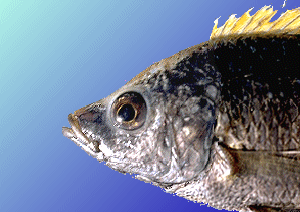
Trophic Adaptations

![]() ne
of the reasons evolutionary biologists are so enchanted by the
cichlid species metaflock of Lake Malawi is that,
because of intense competition for food, the hundreds of species have evolved
many (presumed) specializations to exploit a seemingly endless array of
diets. Some species eat foods typical of "ordinary" fish communities —
vascular plants; insects; small fish. But others are unusual, even unique, in the novel foods exploited,
peculiar structural adaptations, bizarre feeding behavior, use of aggressive mimicry, and other features.
By "adaptation",
I mean "...an anatomical, physiological, or behavioral trait that contributes to
an individual's ability to survive and reproduce ('fitness') in competition with
conspecifics in the environment in which it evolved" (G.C. Williams, 1966. Adaptation
and Natural Selection. Princeton Univ. Press).
ne
of the reasons evolutionary biologists are so enchanted by the
cichlid species metaflock of Lake Malawi is that,
because of intense competition for food, the hundreds of species have evolved
many (presumed) specializations to exploit a seemingly endless array of
diets. Some species eat foods typical of "ordinary" fish communities —
vascular plants; insects; small fish. But others are unusual, even unique, in the novel foods exploited,
peculiar structural adaptations, bizarre feeding behavior, use of aggressive mimicry, and other features.
By "adaptation",
I mean "...an anatomical, physiological, or behavioral trait that contributes to
an individual's ability to survive and reproduce ('fitness') in competition with
conspecifics in the environment in which it evolved" (G.C. Williams, 1966. Adaptation
and Natural Selection. Princeton Univ. Press).
Some examples of Malawi cichlids' trophic (feeding) adaptations, both ordinary and extraordinary, are showcased in the tables below. I hope that this section will be of interest and value to students and teachers of biology classes as well as to more general visitors. For each species, there is a photograph (by M.K. Oliver, unless noted) along with the scientific name of the fish; the species flock to which it belongs (Mbuna or "Hap"); its primary food(s); a brief summary of known or suspected trophic adaptations of behavior, anatomy, and coloration; and pertinent literature. Clicking on any photo will take you to my page for that species, where there may be larger photos and more information.
Piscivores Zooplankton feeders Lepidophages Fin biters Ectoparasite cleaners Molluscivores Crevice feeders Periphyton collectors Aufwuchs feeders Paedophages































